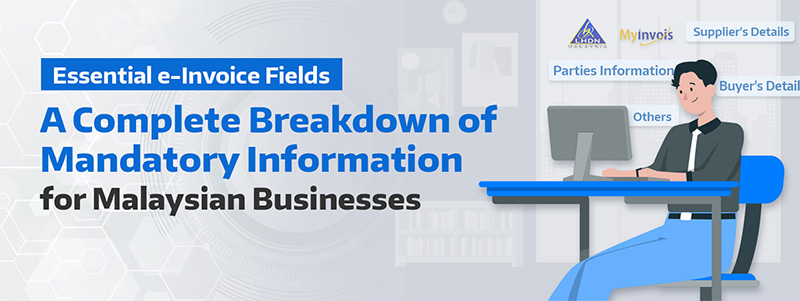
Essential e-Invoice Fields: A Complete Breakdown of Mandatory Information for Malaysian Businesses
As Malaysia transitions to electronic invoicing, understanding exactly what information must be included in a compliant e-invoice has become critical for businesses. While the switch from paper to digital formats brings numerous efficiencies, it also introduces specific data requirements that may differ from your current invoicing practices. This comprehensive guide breaks down all essential fields required in a Malaysian e-invoice, helping your business prepare for the upcoming compliance deadlines.
The Anatomy of a Malaysian e-Invoice
Malaysia's e-invoice system required information to be structured in a standardised format (XML or JSON) that follows the Universal Business Language Version 2.1 (UBL2.1) standard. The required data fields are organised into eight main categories:
- Address
- Business Details
- Contact Number
- Invoice Details
- Parties
- Party Details
- Payment Info
- Products/Services
Let's examine each category and its mandatory fields in detail.
| Category | Mandatory Fields |
|---|---|
|
Category 1: Address Information |
|
|
Category 2: Buyer's Details |
|
|
Category 3: Contact Information |
|
|
Category 4: Invoice Details |
|
|
Category 5: Parties Information |
|
|
Category 6: Products/Services Information |
|
|
Category 7: Supplier's Details |
|
Additional Fields for Specific Scenarios
For Import/Export Transactions (in Annexure):
- Reference Number of Customs Form No.1, 9, etc.
- Required for imported goods in self-billed e-invoices
- Must match the customs declaration document
For Shipping to Different Recipients:
- Shipping Recipient's Name
- Shipping Recipient's Address
- Shipping Recipient's TIN
- Shipping Recipient's Registration Number
- When goods are shipped to someone other than the buyer
Optional but Useful Fields
While not mandatory, these additional fields can provide valuable information:
- Supplier's Email
- Buyer's Email
- Frequency of Billing
- Quantity
- Measurement
- Discount Rate/Amount
- Fee/Charge Rate/Amount
- Payment Mode
- Supplier's Bank Account Number
- Payment Terms
- Prepayment Details
Special Considerations for Different e-Invoice Types
Consolidated e-Invoices
For transactions where buyers don't request individual e-invoices:
- Use "General Public" for Buyer's Name
- Use "EI00000000010" for Buyer's TIN
- Input "NA" for Buyer's Registration Number, Address, Contact Number, and SST Registration Number
- Include all receipt reference numbers in the Description field
- Use classification code 004
Self-Billed e-Invoices
When buyers issue invoices to suppliers:
- Buyer information becomes supplier information and vice versa
- Use the appropriate self-billed classification code (009, 033-037, 045)
- Include the foreign supplier's TIN if available, or use "EI00000000030" if unavailable
Common Mistakes to Avoid
- Incomplete Buyer Information: Failing to collect all required buyer details before issuing e-Invoices
- Incorrect Classification Codes: Using generic codes when more specific ones apply
- Missing Customs References: Omitting customs form numbers for import transactions
- Wrong Currency Handling: Not including exchange rates for foreign currency transactions
- Improper Consolidated e-Invoices: Forgetting to include receipt reference numbers in the description fields
Implementation Strategies
To efficiently capture all required e-invoice fields:
- Update Customer Database: Enhance your customer records to include all required buyer information
- Configure Templates: Create standardised templates for different transaction types
- Train Staff: Ensure all relevant personnel understand field requirements
- Implement Validation: Set up automated validation of required fields before submission
- Document Processes: Create clear SOPs for handling different transaction scenarios
Conclusion
Complying with Malaysia's e-invoice data field requirements may seem daunting at first, but with proper preparation and systems in place, it becomes a manageable process. By understanding exactly what information is required and implementing systematic procedures to capture this data, your business can ensure smooth compliance with the e-invoice mandate when it becomes applicable to your organisation.
Remember that while this guide covers the essential fields, specific industry requirements may apply to your business. Regularly check LHDN's guidelines and updates to ensure your e-invoice practices remain compliant as the system evolves.
About the Author
Mr. Chin Chee Seng is the Independent Non-Executive Director of AutoCount and the Founder of CCS Group.